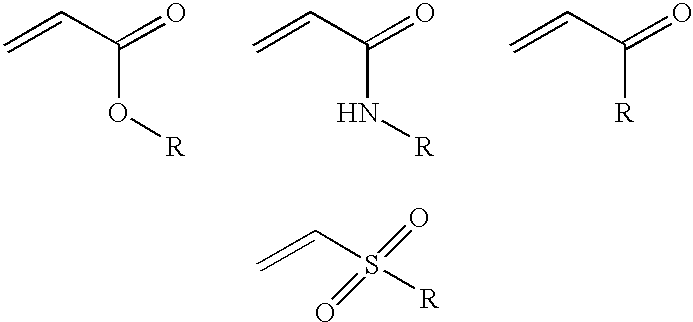Two-phase processing of thermosensitive polymers for use as biomaterials
a biomaterial and thermosensitive technology, applied in the field of polymeric biomaterials, can solve the problems of few methods for generating polymeric materials that meet these stringent requirements, and achieve the effect of negligible cytotoxicity and without adversely affecting the activity of these sensitive molecules
- Summary
- Abstract
- Description
- Claims
- Application Information
AI Technical Summary
Benefits of technology
Problems solved by technology
Method used
Image
Examples
example 2
Preparation of Reactive Pluronic Derivatives
[0071] (a) Preparation of Pluronic F-127 Diacrylate (F127DA).
[0072] 25 g Pluronic F127 were dissolved in 250 ml of toluene and dried with molecular sieves under reflux in a Soxhlet apparatus for 3 hours. After cooling to 0.degree. C., 50 ml of dichloromethane and 1.66 ml of triethylamine (12 mmol) were added under argon. 0.64 ml of acryloyl chloride (7.9 mmol) were dropped into the reaction mixture, and the solution was left for 6 hours under stirring. The mixture was then filtrated, concentrated at the rotatory evaporator, diluted with dichloromethane and extracted with distilled water two times. The dichloromethane solution was dried with sodium sulphate and then precipitated in n-hexane.
[0073] (b) Preparation of Pluronic F-127 Hexathiol (F127HT).
[0074] 4 g of F127DA (pluronic F127 diacrylate) and 1.55 g (molar ratio thiol / acrylate .about.10:1) of pentaerythritol tetrakis (3-mercaptopropionate) (QT) were dissolved in 50 ml of 1-methyl-2-...
example 3
Curing Without Thermal Gelation of Reactive Pluronic Derivatives
[0075] 0.185 g of solid F127DA and 0.065 g of solid F127HT were dispersed in 2 g of PBS pH=7.4, and the mixture was left in an ice bath (0.degree. C.) for 2 hours until complete dissolution. The cold polymer solution (11% wt / wt) was transferred to the rheometer, previously cooled at 5.degree. C. The temperature was then quickly increased until 37.degree. C., and the oscillation test was started (frequency 0.5 Hz, stress 20 Pa) keeping the temperature at 37.degree. C. The gelation point (recorded as the crossing of the elastic and viscous modulus lines) was recorded after 260 sec, while the elastic modulus reached a plateau (corresponding to a value of 10-12 kPa) after a few hours (FIG. 3).
example 4
Curing With Thermal Gelation of Reactive Pluronic Derivatives
[0076] 0.37 g of solid F127DA and 0.13 g of solid F127HT dispersed in 2 g of PBS pH=7.4, and the mixture was left in an ice bath (0.degree. C.) for 2 hours until complete dissolution. The cold polymer solution (20% wt / wt) was transferred to the rheometer, previously cooled at 5.degree. C. The temperature was then quickly increased until 37.degree. C., and the oscillation test was started (frequency 0.5 Hz, stress 20 Pa) keeping the temperature at 37.degree. C. At the beginning of the measurement, the elastic modulus was higher than the viscous modulus, indicating that thermal gelation had already occurred; the curing reaction caused an increase of the elastic modulus, reaching a plateau of 40-50 kPa after 10 hours (FIG. 4).
PUM
| Property | Measurement | Unit |
|---|---|---|
| LCST | aaaaa | aaaaa |
| LCST | aaaaa | aaaaa |
| temperature | aaaaa | aaaaa |
Abstract
Description
Claims
Application Information
 Login to View More
Login to View More - R&D
- Intellectual Property
- Life Sciences
- Materials
- Tech Scout
- Unparalleled Data Quality
- Higher Quality Content
- 60% Fewer Hallucinations
Browse by: Latest US Patents, China's latest patents, Technical Efficacy Thesaurus, Application Domain, Technology Topic, Popular Technical Reports.
© 2025 PatSnap. All rights reserved.Legal|Privacy policy|Modern Slavery Act Transparency Statement|Sitemap|About US| Contact US: help@patsnap.com



